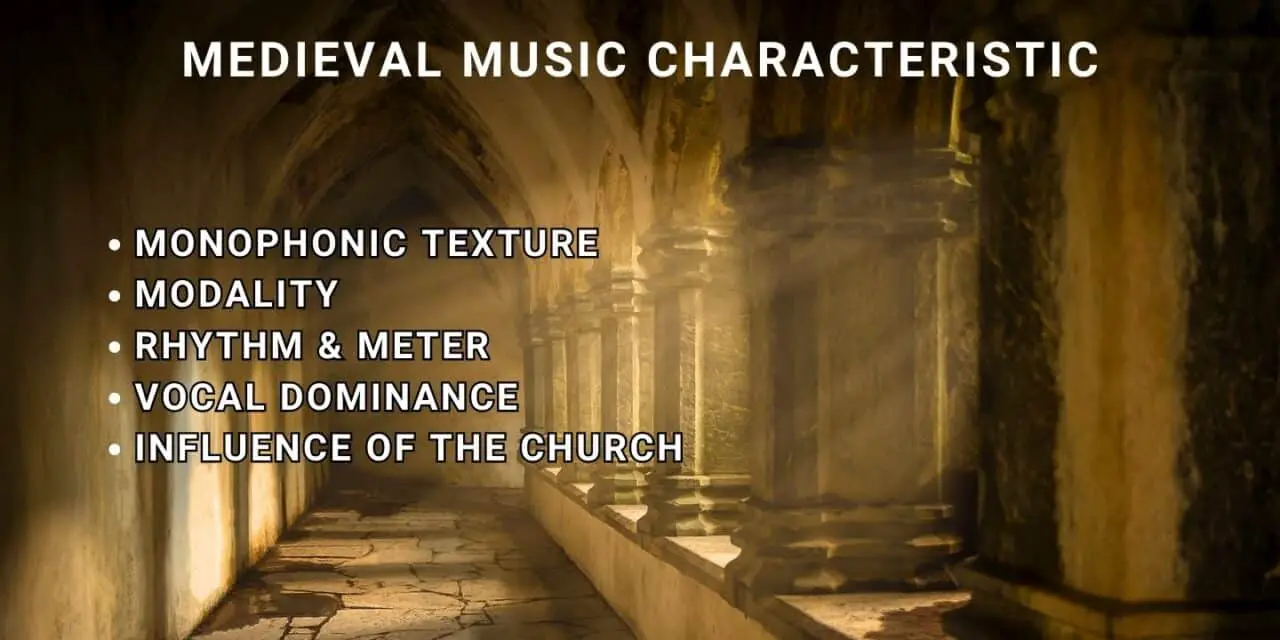The medieval period was an interesting time period for music and melodies with new takes on instrumental music, gregorian chant, and secular vocal music.
We explore the characteristics of medieval music and how it might have influenced western music or classical music as we know it today.
Monophonic Texture
Monophonic texture, as its name suggests, is a musical texture characterized by a single melodic line (whereas polyphonic music would be multiple melodies).
In medieval music, this texture was prevalent in both sacred and secular music, as it allowed for an emphasis on the melodic contour and the text being sung. Monophonic music can be a powerful and evocative form of expression, allowing the listener to focus on the purity and clarity of the melody without the distraction of accompanying harmonies or counterpoints.
One of the most well-known examples of monophonic music from the medieval period is the Gregorian chant. Named after Pope Gregory I, who is believed to have ordered the organization and codification of existing chant traditions, the Gregorian chant was the official music of the Roman Catholic Church for over a thousand years. These chants were typically sung by choirs of monks during liturgical services, such as Mass or the Divine Office, and were performed in Latin, the liturgical language of the Church.
The simplicity and austerity of the monophonic texture in Gregorian chant reflect the spiritual ideals of the medieval Church. Chants were intended to elevate the mind and spirit, fostering a sense of contemplation and unity with the divine. The lack of harmony and instrumental accompaniment in these chants allowed the listeners to focus on the sacred text and its meaning, ensuring that the music served as a conduit for spiritual growth and understanding.
Monophonic melodies were also popular in secular music, frequently performed by roving minstrels, troubadours, and jongleurs. These musicians would amuse both aristocrats and commoners with their music, which frequently recounted tales of chivalry, adventure, and love. The lyric of these songs was able to take center stage because to the usage of a single melodic line, making it easier for listeners to follow the story and connect with the emotional depth of the music.
It is crucial to take into account the circumstances in which this music was written and performed when we examine the monophonic texture of medieval music. The establishment of feudalism, the expansion of Christianity, and the creation of fresh artistic and intellectual movements all occurred during the turbulent medieval era, which saw significant social and political turmoil. People might transcend the difficulties and uncertainties of their day by expressing their deepest feelings, convictions, and aspirations through monophonic music, whether it be in its holy or secular forms.
Monophonic music emphasizes the beauty and complexity of the melody itself as well as the import of the text being sung by concentrating on a single melodic line. In order to connect with their experiences and comprehend the world they lived in, this trait offers a doorway into the thoughts and souls of persons who lived during this unique time in history.
Modality
Modality is another key characteristic of medieval music, setting it apart from the tonal systems used in later periods. Instead of the familiar major and minor scales, medieval musicians and composers utilized modes, or modal scales, which were derived from ancient Greek music theory. These modal scales provided the basis for the melodic and harmonic structure of medieval music, giving it a unique and distinct tonal character.
There are typically eight modes or “church modes” used in medieval music, each with its own characteristic melodic patterns and emotional qualities. These modes are the Dorian, Phrygian, Lydian, Mixolydian, Aeolian, Ionian, Hypodorian, and Hypophrygian. While some modes may evoke a more contemplative or melancholic mood, others can inspire a sense of joy or exuberance.
The use of modality in medieval music allowed for greater creative expression and experimentation. Composers and performers could explore various modes, combining them in different ways to evoke a wide range of emotions and moods. This flexibility in the tonal system was especially important in the context of sacred music, as it enabled musicians to convey the spiritual depth and complexity of the liturgical texts.
The usage of modes also had a huge impact on the sound and personality of songs in secular music. To emphasize the key story elements of love, chivalry, and adventure, for instance, troubadours and minstrels frequently used modal tunes in their songs. These musicians had access to a wide range of tonal colors thanks to the various modes, which enabled them to write distinctive songs that connected with their audiences.
Understanding how this tonal scheme affects the overall personality and aesthetic of the music is crucial as we dig into the world of modality in medieval music. Medieval musicians were able to express a rich tapestry of emotions and moods through the employment of modes, which also gave them access to a special and distinctive tonal vocabulary that reflected the intricacies and subtleties of human experience. We can better grasp medieval artistic sensibilities and appreciate the music’s timeless beauty by viewing things through the prism of modality.
Rhythm and Meter
In medieval music, rhythm and meter played a crucial role in shaping the overall structure and character of the compositions. The treatment of rhythm and meter during this period, however, was quite different from what we are accustomed to in later Western music. This unique approach contributed to the distinctiveness and charm of medieval music.
In the early medieval period, rhythm was often fluid and unmeasured, particularly in medieval music like Gregorian chant. The rhythm followed the natural flow of the text, with the melody adapting to the syllables and accents of the Latin words. This approach created a sense of spontaneity and freedom in the music, allowing it to breathe and unfold organically.
As the medieval period progressed, a more structured approach to rhythm emerged, known as rhythmic modes. These modes were based on recurring patterns of long and short durations, similar to the concept of meter in modern music. Rhythmic modes were especially prevalent in the Notre Dame school of polyphony, which flourished in the 12th and 13th centuries. Composers such as Léonin and Pérotin used these modes to create complex and intricate polyphonic textures, showcasing their ingenuity and mastery of the musical craft.
In secular music, rhythm played a vital role in creating a lively and engaging atmosphere. Dance music, for example, often featured repeating rhythmic patterns that were easy to follow and encouraged movement. Additionally, the songs of troubadours, minstrels, and jongleurs often employed rhythmic devices like syncopation and hemiola to add interest and excitement to their compositions.
The development and evolution of rhythm and meter in medieval music highlight the period’s innovative spirit and artistic diversity. As composers and performers experimented with new rhythmic ideas and techniques, they created a rich and varied musical landscape that continues to captivate listeners today. By examining the rhythm and meter in medieval music, we gain a deeper appreciation for the creativity and skill of the musicians who brought this fascinating era to life.
Vocal Dominance
Vocal dominance is a defining characteristic of medieval music, reflecting the central role of the human voice in both sacred and secular contexts. During this period, vocal music was the primary focus, with instrumental music often taking a secondary or supportive role. This emphasis on the voice can be attributed to the cultural and religious values of the time, as well as the technical limitations of early musical instruments.
In the realm of sacred music, the importance of the human voice was closely linked to the spiritual beliefs of the medieval Church. Vocal music, such as Gregorian chant and polyphonic motets, was considered a direct expression of the divine and a means of connecting with the spiritual realm. The purity and beauty of the human voice were believed to evoke a sense of transcendence, drawing listeners closer to the divine presence. Consequently, vocal music was an essential part of the liturgy, and composers dedicated much of their efforts to creating complex and moving choral works.
The late medieval period witnessed the emergence of polyphony, a technique in which multiple independent voices or melodic lines are sung simultaneously. This development added new layers of complexity and richness to vocal music, as composers experimented with the interplay of voices and the harmonies they produced. Works by composers such as Guillaume de Machaut and Josquin des Prez showcase the extraordinary beauty and intricacy of polyphonic vocal music, which would continue to evolve and flourish in the subsequent Renaissance period.
In secular music, the human voice played an equally important role. Minstrels, troubadours, and jongleurs used their voices to tell stories, convey emotions, and entertain their audiences. These performers composed and sang songs on a wide range of topics, from love and courtship to chivalry and war. The focus on the voice in secular music allowed the text and the narrative to take center stage, engaging listeners and fostering a shared sense of community.
In conclusion, the dominance of vocal music in the medieval period reflects the cultural and spiritual values of the time. Through the power and expressiveness of the human voice, composers and performers were able to create deeply moving and inspiring works that continue to resonate with modern audiences. By studying the role of vocal music in the medieval era, we can better understand the artistic priorities and sensibilities of the period, enriching our appreciation for this fascinating chapter in music history.
Text and Music Relationship
The relationship between text and music is a crucial aspect of medieval music, as it shaped the way composers and performers approached their craft. In both sacred and secular music, there was a strong connection between the text and the music, with composers seeking to enhance the meaning and emotional impact of the text through their musical choices. This interplay between text and music is a key element in understanding the artistic goals and methods of the medieval period.
In medieval music, the liturgical texts served as the foundation upon which the music was built. Gregorian chants, for example, were designed to follow the natural flow of the Latin text, with the melody adapting to the syllables and accents of the words. This approach created a sense of unity between the text and the music, ensuring that the sacred message was clearly conveyed and comprehended by the listeners. As polyphony emerged in the late medieval period, composers continued to prioritize the text, using techniques such as text painting to reflect the meaning of the words through the interplay of voices and harmonies.
The interaction between word and melody was crucial in secular music. Songs having a narrative form were frequently written by troubadours, minstrels, and jongleurs, who used them to convey tales of romance, bravery, and adventure. These songs’ melodies and rhythms were deliberately designed to complement and enhance the story, allowing listeners to connect with the music’s emotional substance. A sweet love song, for instance, can have a soft, swaying melody, but a brave story of battle might have a more forceful, rhythmic tune.
The importance of storytelling and communication in the medieval musical culture is highlighted by the focus on the connection between text and music throughout that time. By utilizing the ability of music to communicate complicated concepts and emotions, composers and performers aimed to produce works that not only amused but also informed and inspired their listeners. We can learn more about the creative principles and values that influenced medieval music by looking at this important part of it.
Influence of the Church
The influence of the Church on medieval music cannot be overstated, as it played a significant role in shaping the development and evolution of musical practices during this period. The Catholic Church was not only an essential patron of music but also a driving force in the establishment of musical traditions and the dissemination of musical knowledge.
One of the most prominent examples of the Church’s impact on medieval music is the development and standardization of Gregorian chant. As the official music of the Roman Catholic Church, Gregorian chant was an integral part of the liturgy, serving to enhance the spiritual experience of the faithful. The Church’s patronage and support for the creation, preservation, and performance of these chants ensured their lasting influence and widespread adoption throughout the medieval world.
The Church was also instrumental in the development of medieval music notation and the evolution of music theory. Early forms of notation, such as neumes, were developed to aid in the memorization and performance of sacred music. As music became more complex, particularly with the advent of polyphony, the need for a more precise and standardized system of notation arose. The Church’s support for the study and refinement of musical notation led to the development of the staff notation we know today.
Additionally, the Church played a key role in the education and training of musicians. Monastic schools and cathedral schools served as important centers of learning, where young musicians would study singing, notation, and the fundamentals of music theory. The Church’s emphasis on the importance of music in the liturgy and the spiritual life of the faithful ensured that the art of music was nurtured and cultivated throughout the medieval period.
In the realm of secular music, the Church’s influence can also be observed. Many secular musicians, such as minstrels and troubadours, were exposed to sacred music through their participation in church services or their education in church-sponsored institutions. This exposure undoubtedly shaped their approach to composition and performance, with elements of sacred music often finding their way into secular songs and instrumental music.






